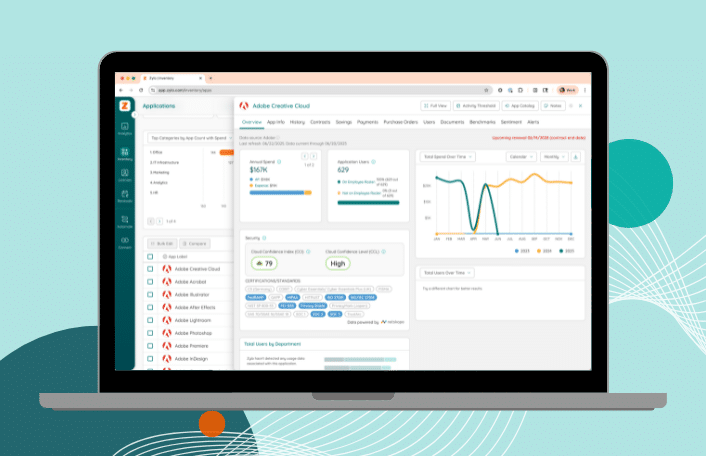
From Chaos to Control: Applying FinOps Thinking to SaaS
Table of Contents ToggleChart a SaaS Management JourneyChallenge No. 1Transition from...
Back
Back
Search for Keywords...
Blog

Table of Contents
As part of its ongoing focus on developing not only effective SaaS management products but a SaaS management community, Zylo recently invited a roundtable of innovative enterprise technology leaders to discuss the challenges of enterprise SaaS management.
The companies these leaders represent vary in age (some founded decades ago, others relatively new) as well as industry (software, finance, and transportation). This varied experience extended to software systems: Some companies were born in the cloud; others utilized a mix of on-premise and cloud technologies.
While there are distinct differences in each company’s make-up, a few enterprise SaaS management themes quickly materialized. Although relatively new, the following SaaS challenges will continue without a proactive SaaS management methodology.
If developing a SaaS Management strategy for the enterprise is a footrace, many organizations are at the start line: They’re poised and ready to answer the challenge but have yet to identify the best practices for this new business process.
The proposed finish line? A comprehensive strategy for SaaS that visualizes SaaS applications and their lifecycle throughout the organization. This vision includes access to a centralized record of SaaS metadata within the business and a governance framework with flexible views and controls.
Every organization represented at the roundtable acknowledged that the challenge of enterprise SaaS Management was most pronounced with the acute challenge of shadow IT. Acknowledging the risk of unknown, unvetted, and costly software in the organization without clear ownership has been the starting point for many enterprise IT leaders, but other challenges were also notable.
Here are a few examples of organizational challenges enterprise tech leaders defined for their organizations when it came to managing SaaS.
Many enterprise firms have traditionally employed SAM for centralized management of on-premise software. The practice includes the monitoring of software usage, procurement, deployment, risk management, licensing, and compliance throughout the lifecycle.
To avoid license audit inaccuracies, uncover potential cost savings, and increase utilization of key applications, SAM has become a core business function for many legacy enterprises.
In light of growing SaaS-specific challenges, the SAM-only model may soon be outdated.
Roundtable participants noted that the growing adoption of SaaS by buyers external to IT disables SAM managers from controlling all software acquisition and management. The now widespread ability to purchase and implement SaaS has changed the game and created a new software ecosystem that’s less visible and more difficult to optimize.
Anyone with an expense account, company credit card, or reimbursement request can now purchase and implement new software. Zylo data backs this up: About 74% of SaaS spending outside of IT’s budget. Software acquisition has become the “Wild West,” through the lens of SAM.

To adapt, IT leaders must be enabled to discover their SaaS landscape, including applications currently acquired or deployed from lines of business other than IT. Roundtable participants noted that gaining visibility was the first and foremost primary concern with any SaaS management initiative.
The next logical step is to integrate the SAM best practices that can be appropriately translated – including license optimization, utilization measurement, and proactive renewal planning – into an enterprise SaaS management framework.
While SAM practitioners noted challenges around identifying spend and assigning ownership, for sourcing and procurement leaders, wrangling the financial accountability of SaaS transactions is the most immediate need.
Sourcing leaders mentioned that uncontrolled SaaS purchases and acquisition lead to sizable cumulative impacts on the bottom line, including unplanned multiple fold increases to software budgets. Not only are sourcing teams responsible for containing growing SaaS costs where possible, but they’re also responsible for deriving new value out of current SaaS purchases.
With these tasks in mind, sourcing leaders identified the first step of “defining the known universe,” which is creating a fully visible and accurate picture of SaaS spend across the organization.
Once identified, confronting shadow IT can lead to multiple avenues to proactively drive SaaS application value and cost containment, including:
The last SaaS challenge scenario noted by roundtable participants overlapped many specialties: Rapid additions to employee headcount due to rapid growth or mergers and acquisitions.
While due diligence prior to accelerated growth or the M&A may have revealed some leading indicators of what the new organization’s tech stack will look like – including SaaS applications – roundtable participants noted that these business activities were the quickest way to accumulate shadow IT.
And for good reason. According to Gartner, shadow IT makes up 30 to 40 percent of IT spending at large enterprise organizations. When viewed in the light of M&As or rapid acquisition of headcount (converting a large contractor network into full-time employee status, for example), shadow IT creates security risks, cost containment challenges, and barriers to proper integration.
To define the new world of a merged or suddenly larger organization, tech leaders present at the roundtable highlighted the need for an enterprise-wide SaaS audit and ongoing discovery. These leaders also noted the difficulty of exposing all applications bought across multiple newly acquired locations or teams without a central record or SaaS management platform.
Like other participants, technology managers and directors at businesses with rapid growth or M&A activities placed their organizations squarely at the beginning of their SaaS management journey. However, they noted that once they established SaaS management processes via discovery, they planned to take additional steps to develop processes to optimize software value and mitigate risk in a continuing cycle.
Enterprise organizations of all stripes, make-up, and backgrounds face a distinctly similar challenge: Undoing the chaos from the uncontrolled proliferation of SaaS applications.
In the light of these challenges, tech leaders at the leading edge of establishing SaaS management principles are concerned with creating enterprise systems of management that provide visibility, tools for collaboration, opportunities for cost containment, and governance for flexible ownership.
ABOUT THE AUTHOR

Eric Christopher
Eric Christopher is CEO and Co-Founder of Zylo, the leading SaaS management platform. After 14 years of buying and selling software, Eric knew there had to be a better way to manage cloud applications within a company. Eric started his career in sales at ExactTarget from 2002 to 2010. He spent the next six years in Chicago leading sales teams at Shoutlet and Sprout Social Inc., and founded Zylo in 2016.

Table of Contents ToggleChart a SaaS Management JourneyChallenge No. 1Transition from...

Table of Contents ToggleWhy Data Integrity Breaks DownWhat Does Data Integrity...

Table of Contents ToggleChart a SaaS Management JourneyChallenge No. 1Transition from...

Table of Contents ToggleShelfware DefinedWhy Shelfware HappensPoor Organizational OversightShadow IT and...
| Cookie | Duration | Description |
|---|---|---|
| cookielawinfo-checkbox-analytics | 11 months | This cookie is set by GDPR Cookie Consent plugin. The cookie is used to store the user consent for the cookies in the category "Analytics". |
| cookielawinfo-checkbox-functional | 11 months | The cookie is set by GDPR cookie consent to record the user consent for the cookies in the category "Functional". |
| cookielawinfo-checkbox-necessary | 11 months | This cookie is set by GDPR Cookie Consent plugin. The cookies is used to store the user consent for the cookies in the category "Necessary". |
| cookielawinfo-checkbox-others | 11 months | This cookie is set by GDPR Cookie Consent plugin. The cookie is used to store the user consent for the cookies in the category "Other. |
| cookielawinfo-checkbox-performance | 11 months | This cookie is set by GDPR Cookie Consent plugin. The cookie is used to store the user consent for the cookies in the category "Performance". |
| viewed_cookie_policy | 11 months | The cookie is set by the GDPR Cookie Consent plugin and is used to store whether or not user has consented to the use of cookies. It does not store any personal data. |
